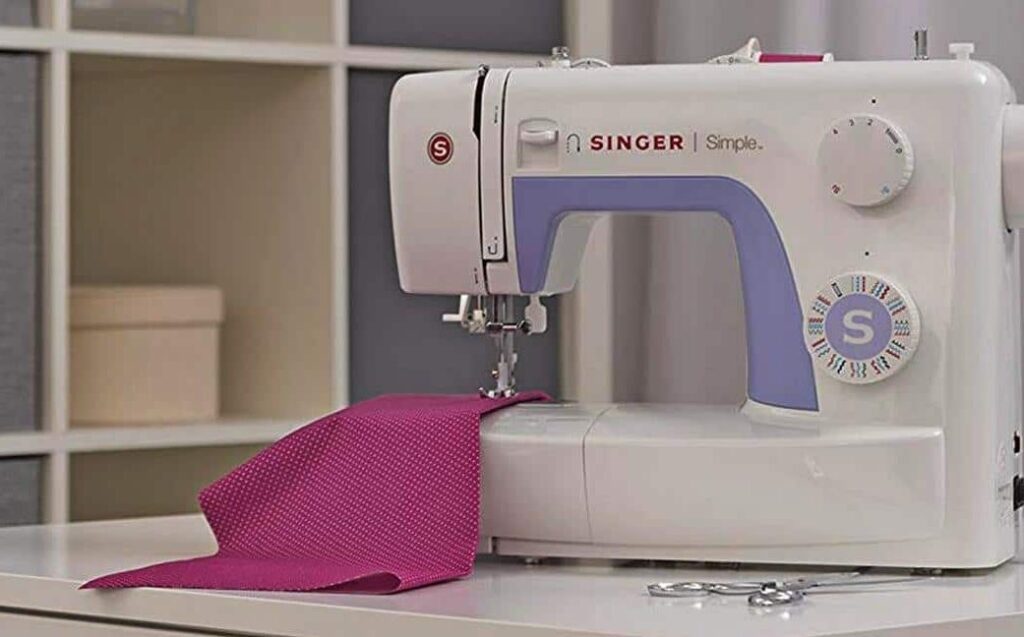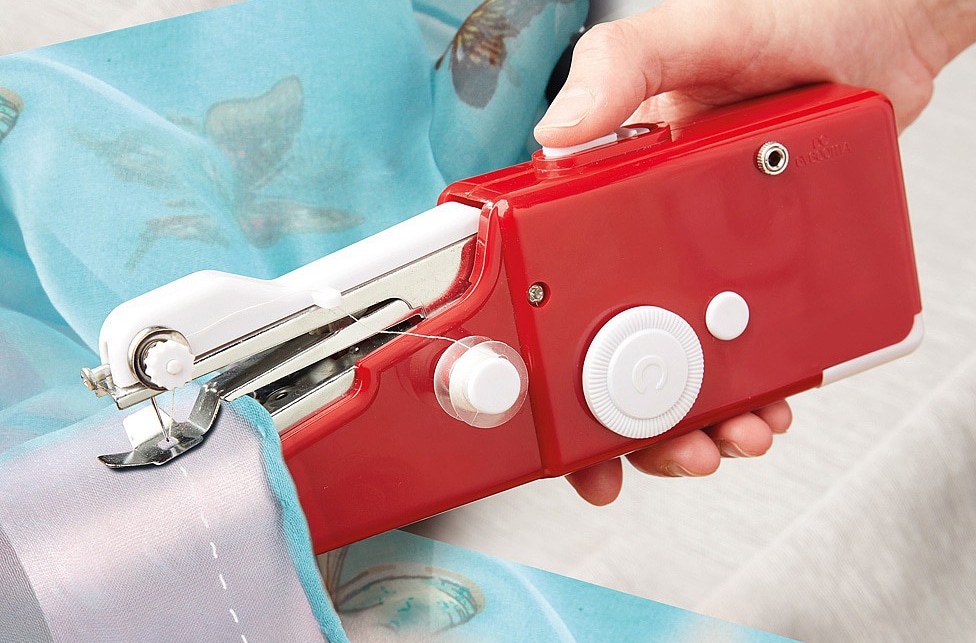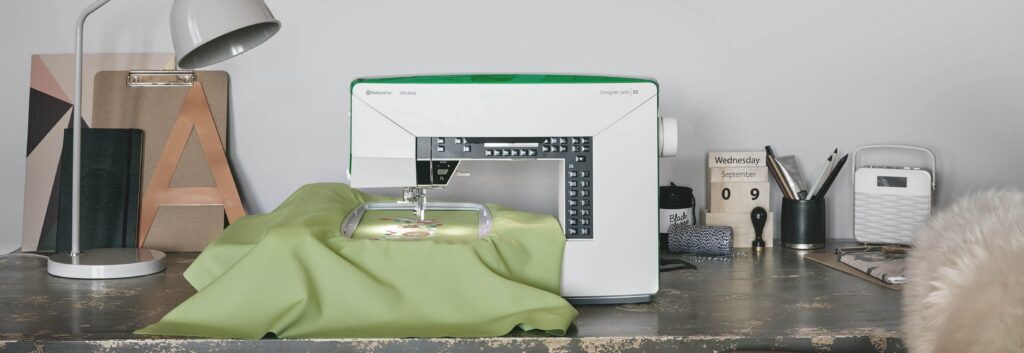If you’re like most people, the mere mention of a serger sewing machine probably sends shivers down your spine. You may not even know what one is, but just the thought of it conjures up visions of tangled threads, broken needles, and hours upon hours of frustration. Fortunately, it’s not that scary if you choose the right machine.
When preparing this article, we went through more than 20 different models to narrow down our selection to the 5 best serger sewing machines. The ability to use multiple stitches is unique to these machines, so the number of them was an important consideration. Serger machines are also supposed to be fast, so we considered the speed of the motor, which can reach 1500 stitches per minute in some models. All things considered, we decided that the Brother 1034DX is worthy of becoming the Editor’s Choice.
Other features: comes with an instructional DVD; includes a removable trim trap
A true workhorse that offers the benefits of high-end machines, but at a much lower price point, the Brother 1034DX serger is an excellent choice for novice and seasoned serger enthusiasts. This model is one of the easiest to thread given its color-coded and numbered threading instructions.
One of the most appealing aspects of this machine is that it lets you adjust your stitch width easily. You can go anywhere from between a 5mm – 7mm range for creating bold designs. You can also take advantage of the removable free arm feature and enjoy an impressive speed of 1,300 stitches per minute.
Work with the freedom of using 3-4 different threads simultaneously to make your sewing projects even more unique. There is a 22-stitch function along with ribbon lock, rolled hems to give your work that professional touch. This serger also has a built-in retractable knife blade that can be used for trimming edges. This feature will also help you align the fabric neatly taking all the guesswork out of your sewing.
With this model, you get a responsive, easy-to-use machine that can well become your serging partner for life.
Other features: comes with an all-purpose foot, needle set, tweezers, spreader (for 2 thread stitches), small screwdriver, foot control, power cord, instruction manual with included stitch guide
The CG in this machine’s name, Singer 14CG754 stands for Commercial Grade letting you experiment with many different serging options. It offers you a six-stitch option including flatlock, rolled hem, four-thread mock stretch and two stretch overlock stitches among others.
This model works well with many types of fibers including natural and synthetic. You can even work on active wear fiber easily and stitch your own yoga pants and workout outfits.
Like many others in this category, this Singer serger also offers a speed of 1,300 stitches per minute. You can also adjust the stitch width and length based on the type of details you are creating. Try your hand at making ruffles by changing the feed ratio, or use your machine for pucker-free stitching.
That said, the Singer 14CG754 offers all the basics of serging as well, making it a good fit for people who are just starting out with serging. If you’re in the market for a perfect serger, but not sure about your serging skills, this may be the machine to opt for. Featuring a very reasonable price tag, with adequate serging features, this is our Budget Pick on this list.
Other features: comes with a needle set, four thread nets, tweezers, four spool caps, four spool mats, a cleaning brush, a hexagonal wrench, a soft cover, and an operating manual
Aptly named the Brother 2340CV Cover Stitch, this is a serger designed to provide a variety of cover stitches for function and decoration. This is a heavy duty sewing machine which gives you multiple distinct features for the money. This model features 1-2-3 needle options and works well to create a variety of cover stitches on multiple types of fabric.
You can work on casual projects as well as decorative styles with the 2340 CV. Its versatility will let you tackle stretchy garments such as swimsuits as well as dance attires while working on interior edges and decorative stitching on less challenging fabrics. The Cover Stitch will provide beauty, durability, and protection to your garments and fabric from fraying.
This serger will match the competition offering 1,300 stitches per minute like many others on this list. The adjustable stitch length on this model ranges between 2-4 mm.
Easily featuring the biggest stitch width range on the list, this serger lets you adjust stitches between 2.3-7 mm wide. This feature may well be one of its strongest points as you get stitch width control not available with other competitor models.
Because it is made for cover stitching, you can also attach elastic, tape, lace and work with circular hems for collars and cuffs. This also means that this serger won’t cut while sewing like a standard model would. When compared with other models, this offers the quietest operation by far.
Other features: knife system with dedicated drive mechanism; sews light to medium weight fabric
If you sew against the clock, then this Juki model may just be your best friend. The Juki MO644D offers an exceptional speed of 1,500 stitches per minute leaving standard sergers behind. It also offers seven stitching functions including both 3 and 2-thread rolled hem, 3-thread flatlock and much more.
In addition, you can get the perfect finish with functions like piping, beading, cording, blind stitching and adding elastic. Plus, its multi-functioning foot will let you add on other accessories like tape and sequins.
The Juki MO 6448 is also an ideal option when it comes to working with layers without compromising thread tension. The serger works quietly and solidly with minimal vibration giving smooth results. You can use it with a range of fibers from natural and fine fibers to knits, synthetics, and everything in between. However, it is not suitable for upholstery, leather, fur, canvas, or plastic.
Despite its multifunctional capacity and immense speed, the Juki is a compact and easily portable sewing machine. Measuring only 10.6 x 13.4 x 11.6 inches makes Juki the most compact model on this list. When you invest in this model, you give your projects a professional touch with all its diverse functions.
Other features: comes with two sets of starter thread, a blind hem stitch foot, a gathering foot, and a piping foot
Definitely one of the more interesting and advanced models on the list, this serger from Brother has all the aesthetics and functions in place. This model features a 3-4 thread capability with 23 of its own built-in stitches. You can work at a speed of 1,300 stitches per minute and choose from different options like 3-4 thread overlock, narrow, rolled hem, and ribbon lock stitches.
Both the stitch length and width are adjustable with ranges between 2-4 mm and 3-7 mm respectively. With this option, you have the choice of different sized stitches that will create flat seam finishes even on lighter fabrics.
This model has three interchangeable feet including a gathering, a piping and a blind hem stitch foot. Of these, the first gathers and connects fabric while giving it a finished edge. The second guides narrow piping and holds zippers in place, while the third joins and stitches edges or attaches fabric pieces together.
These three presser feet on this model can be raised to a maximum height of six mm, giving you plenty of space to work with thicker fabrics or multiple layers. The adjustable differential feed ratio adds to this convenience further allowing you to use delicate or thick fabrics without any hassle.
Packing so many different features in one machine, this serger easily tops the list for the most versatile unit available.
If you want to take your sewing up several notches (think professional standard), then you definitely need to upgrade to a serger. These machines make sewing fun while giving your product a professional look. In this guide we’ll take a look at the most important features you need to consider before making your final choice.
The easiest way to determine if you need a serger is to take one homemade item of clothing and another store bought item. Now compare the seams and thread to see how much more a serger can do.
Not only does this machine sew the seam allowance and fabric edge but also overcasts the edges as well. It sews the two together while trimming the extra fabric. You can finish edges and seams quickly and embellish with decorative thread using cover or chain stitches.
As you will see looking at a serger machine, threading is a multifold task. If you have a hard time threading your regular sewing machine, then brace yourself, for you’ll have to thread a couple of times more to get your serger started. Along with the challenge of threading, you will also have to look at some other special features to make sure you get the best machine that complements your sewing needs.
Sergers come in different varieties ranging from 2-4 thread sergers to 5 thread sergers. The advantage of the extra threads is that you get the option of working with wider seams. The same also give you more stretch in the fabric along with a higher degree of durability and strength in your finished product.
A greater number of threads will also facilitate working with different types of fabrics. Whereas regular sewing machines can make it difficult to work with stretchy materials such as knitted fabrics, a serger will work with these smoothly.
A 2-4 thread serger gives you two threads on a straight stitch with the other two on the overcast stitch. A 3-4 thread machine yields a wider and stronger seam as it can roll the fabric edges to the underside and catch them with the bottom thread. A 5 thread serger uses three threads on the overcast and two on the straight stitch.
One of the perks of owning a serger is that it lets you work at a much higher speed than regular sewing machines. As such, you would want to find a model that gives speed along with performance and still lets you complete your project with a neat and tidy finish.
Motor speeds for sergers can range from 1,000 stitches to 1,500 stitches with most models yielding 1,300 stitches per minute. Look for a model that offers at least 1,300 stitches per minute (you can choose from the many that we have recommended here). All the models from Brother as well as the Singer ProFinish will give you these many stitches per minute, while the Juki will up your game by 1,500 stitches.
The one concern here is to keep the noise level in mind. Often, the faster the motor goes, the louder it gets.
That said, the Brother 2340CV and Juki MO644D have earned praised for their super quiet performance.
The stitch width feature is an important one when serging. It allows you to modify the width of your stitches as you create designs or edging, or add stylistic features to your work.
But the stitch width setting on your serger does more than control how wide the stitch is. It also moves the cutting blade on your machine. This feature lets you wrap your stitches exactly at the fabric edge. If your cutting width is too narrow, it will result in the stitches hanging off the fabric edge. You should increase the cutting width until the thread meets the edge of the fabric.
Every serger comes equipped with two sets of feed dogs to move the fabric through the machine. The differential feed or feed ratio controls the movement of both the front and rear feed dogs.
When set at the feed ratio of 1, which will be the default ratio on most machines, both feed dogs move along at the same speed. When you adjust the feed ratio to less than one, the front feed dogs move slower that their rear counterparts. You may wish to do this when working with lightweight fabrics that pucker. This low setting will stretch the fabric as you sew and prevent puckering.
When the feed ratio is set to greater than one, the front feed dogs move faster than those at the rear and gather fabric as it gets sewn. This setting is helpful for removing rippling when serging stretches fabric.
Serger dimensions vary based on model with most models being slightly larger than sewing machines. However, you have to keep storage in mind.
Chances are if you want to invest in a serger machine, you already possess a sewing machine. So always check product details to see if your new serger will fit in your available space.
Look for a brand that comes with a solid warranty. Most reputable brands will offer a substantial warranty spanning around the 25-year mark. From our recommended list of products, all models by Brother as well as the Singer ProFinish meet this requirement.
The warranty establishes the confidence of the company in their product and is a show of goodwill that their machine will offer durability along with performance. Since quality sergers don’t come cheap, we recommend looking for something backed by a warranty to make the purchase worth your investment.
Sergers have standard features that you should never scrimp on. However, the higher the price, the more special features you get.
Because threading seems to be a common deterrent among those new to serging, and even among seasoned sergers, you may want to look into a model that includes automatic threading. Another extra feature is to look for additional feet as this instantly broadens not only the options but also the scope of your work. Models that come with additional accessories are good investments as accessories can be quite expensive to purchase separately.
If you’re a beginner, then go with a regular sewing machine and see how much more you need to add to your sewing experience.
Although it is a fairly specialized piece of equipment, buying a quality serger machine doesn’t have to be overwhelming or confusing. If you know exactly what you’re looking for, our list here covers sergers of all types.
If ease-of-use is your priority, then consider getting the Brother 1034DX as it is a well-rounded serger. Setup and operation of this unit is easy and it has won many accolades from novice and seasoned sergers alike.
If you don’t have the cash to dish out on a serger, then take a look at the Singer Profinish which will give you the professional touch you’re looking for without taxing your wallet too much.
However, if you want to opt for heavy duty performance, take a look at the Brother 2340CV. With this machine you can create stitches between 2.3-7 mm wide, and it works equally well to create cover stitches on multiple types of fabric.





